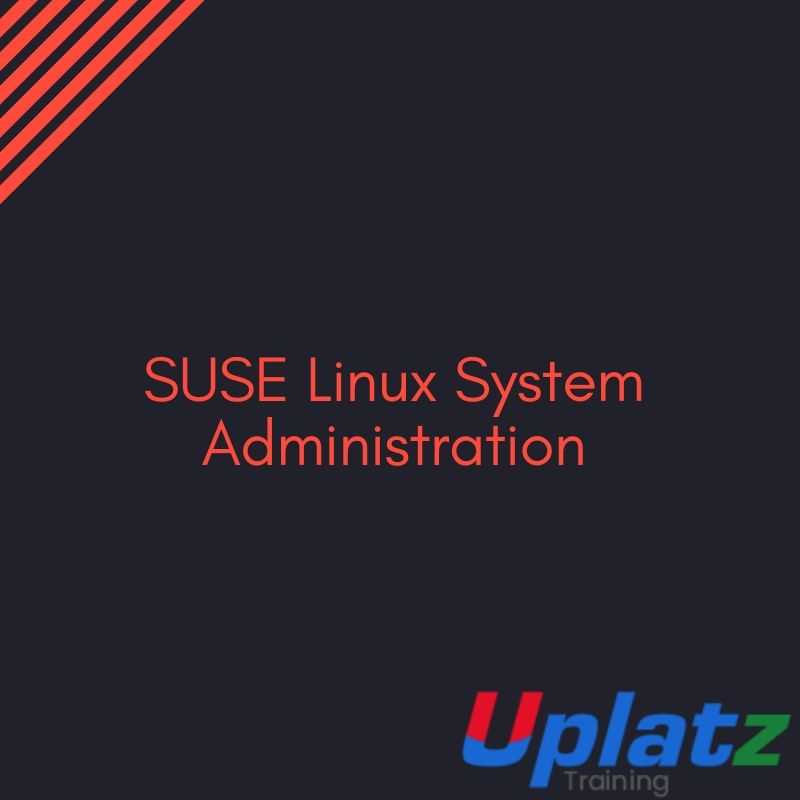SUSE Linux System Administration

SUSE Linux System Administration Course Overview
This instructor led SUSE Linux System Administration training course is designed to teach the key administration, security, networking and performance tasks required on a SUSE Linux Enterprise Server (SLES).
Similarly, the course is targeted to closely follow the official Linux Professional Institute (LPI) and CompTIA Linux+ certification curriculums.
-----------------------------------------------------------------------------------------------------------------------------------------
Who will the Course Benefit?
The SUSE Linux System Administration training course is suitable for novice Linux System Administrators, Programmers and other technical IT staff who need to acquire administration knowledge of the key administrative, networking, performance and security tasks required on a SUSE Linux operating system within the Enterprise.
Delegates who wish to work towards achieving the Linux Administrator LPIC-1 or CompTIA Linux+ certifications will find this course a good basis for LPIC-1: 101-500 and 102-500 exams or CompTIA Linux+: LX0-103, LX0-104 and XKO-004 exams.
The appendixes also include other related topics that would be useful reading for delegates preparing for certification.
-----------------------------------------------------------------------------------------------------------------------------------------
Course Objectives
On completion of this course the delegate will have the required technical knowledge to administer a SUSE Linux server within the Enterprise. They will have gained practical experience of configuring administrative, networking, performance and security aspects of a SUSE Linux Enterprise system (SLES).
The delegate will possess the essential knowledge required to study towards the Linux Administrator LPIC-1 and CompTIA Linux+ certifications.
-----------------------------------------------------------------------------------------------------------------------------------------
This is a SUSE Linux System Administration course by Uplatz.
SUSE Linux System Administration
SUSE Linux System Administration Training Course
Course Introduction
- Administration and Course Materials
- Course Structure and Agenda
- Delegate and Trainer Introductions
Session 1: FILE SYSTEM CONFIGURATION
- File system types
- Partitioning a disk
- Creating filesystems
- Displaying disk usage
- Mounting and unmounting file systems
- Locating files in use
- Exercise
Session 2: ADVANCED FILE SYSTEM OPERATIONS
- Logical Volume Management
- Checking and repairing the file system
- Growing file systems
- Disk quotas
- Listing swap areas
- Creating and removing swap areas
- Exercise
Session 3: USER ACCOUNT MANAGEMENT
- The User Private Group scheme
- Files used in creating a user
- Adding users via the command line and YaST
- Groups
- Password administration
- The Bash Shell environment
- Configuring user limits
- Extended permissions
- The sudo command
- User monitoring and communication
- Exercise
SUSE Linux System Administration Training Course
Session 4: PACKAGE MANAGEMENT
- The Red Hat Package Manager(rpm)
- Verifying Software
- Querying installed packages
- Installing packages
- The upgrade mechanism
- Removing packages
- Converting rpm packages to cpio format
- Extended package management
- Exercise
Session 5: SYSTEM STARTUP AND SHUTDOWN
- System startup process
- The startup script framework
- Managing services using YaST
- Starting and stopping services dynamically
- Managing services with systemd
- suseconfig and /etc/sysconfig
- shutdown and rc
- Exercise
Session 6: CONFIGURING PRINTERS
- The Common Unix Printing Service CUPS
- Printer devices and configuration
- Installing printers
- Configuring the CUPS server
- Printer options
- Print commands
- Managing print queues
- Exercise
Session 7: PROCESS MONITORING AND SCHEDULING
- Monitoring processes
- Shared libraries
- Scheduling processes with at
- Scheduling processes with cron
- crontab command options
- Managing anacron
- Exercise
SUSE Linux System Administration Training Course
Session 8: SYSTEM SECURITY AND ENCRYPTION
- The secure shell OpenSSH
- Public/private key authentication
- X11 forwarding
- Encryption with GNU Privacy Guard GPG
- crontab command options
- Exercise
Session 9: CONNECTING LINUX TO THE NETWORK
- Basic network configuration
- IPv4 addressing
- IPv6 addressing
- Network protocols
- Network services and port numbers
- Managing network devices
- Hostnames and DNS
- Searching domains
- Routing under Linux
- Exercise
Session 10: INTERNET SERVICES
- Network services
- The xinetd daemon
- Protecting services with TCP wrappers
- Checking network service ports
- Configuring network time
- Interacting with the hardware clock
- Remote administration
- Exercise
SUSE Linux System Administration Training Course
Session 11: BACKUP AND RESTORE
- Archiving with tar
- Archiving with cpio
- Using the dd command
- Archiving and compression
- Other backup tools
- Exercise
Session 12: LOCALISATION
- Localisation overview
- Locale variables
- Character encoding
- Setting the locale
- The time zone
- Converting character sets
- Exercise
Session 13: VIRTUALISATION AND CLOUD COMPUTING
- An overview of virtualisation and containers
- Linux Containers
- Application Containers
- Iaas cloud
- Exercise
SUSE Linux System Administration Training Course
Session 14: DEVICES UNDER LINUX
- Device services
- Device file naming conventions
- The /sys directory
- Examining hardware
- Hardware configuration messages
- Software configuration messages
- System bus support
- Managing disk parameters
- Detecting new hardware
- System overview: siga
- Exercise
Session 15:SYSTEM LOGGING
- rsyslog configuration
- Testing using logger
- Managing logs with logrotate
- The systemd journal: journalctl
- Exercise
Session 16:TROUBLESHOOTING
- The troubleshooting process
- Booting into maintenance mode
- Booting the rescue system
- Exercise
Addendum: Reference Materials (provided within the course handbook for additional reading)
APPENDIX A - INSTALLING LINUX
- Installing Linux
APPENDIX B - ELECTRONIC MAIL
- Configuring Postfix and Sendmail
- Mail commands
APPENDIX C - X WINDOWS AND ACCESSIBILITY
- Configuring the X Windows GUI interface and desktops
- Installing alternative desktops
- Configuring the desktop for disabled users
APPENDIX D - PACKAGE MANAGEMENT
- Additional software package management tools
APPENDIX E - ADDITIONAL COMMANDS
- Miscellaneous Shell commands
Attending this course will help the delegate gain many of the skills and product knowledge requirements as outlined in the exam objectives. Studying this course and its associated reference materials can form part of the preparation to achieve certification. Experience, practice, self-study and aptitude are also key requirements for exam success.
Before taking any exam, ensure you have the recommended experience. The LPI and CompTIA websites list all exam requirements and these are updated regularly.
Exams are not included as part of the course.








